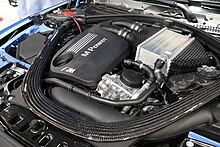Anintercooleris aheat exchangerused to cool a gas after compression.[1]Often found inturbochargedengines, intercoolers are also used inair compressors,air conditioners,refrigerationandgas turbines.


Internal combustion engines
editMost commonly used withturbochargedengines, an intercooler is used to counteract theheat of compressionandheat soakin the pressurised intake air. By reducing the temperature of the intake air, the air becomes denser (allowing more fuel to be injected, resulting in increased power) and less likely to suffer frompre-ignitionorknocking.Additional cooling can be provided by externally spraying a fine mist onto the intercooler surface, or even into theintake air itself,to further reduce intake charge temperature throughevaporative cooling.
Intercoolers can vary dramatically in size, shape and design, depending on the performance and space requirements of the system. Many passenger cars use either front-mounted intercoolers located in the front bumper or grill opening, or top-mounted intercoolers located above the engine. An intercooling system can use an air-to-air design, an air-to-liquid design, or a combination of both.
Multiple stages of compression
editIn automotive engines where multiple stages of forced-induction are used (e.g. asequential twin-turboortwin-chargedengine), the intercooling usually takes place after the last turbocharger/supercharger. However it is also possible to use separate intercoolers for each stage of the turbocharging/supercharging, such as in theJCB Dieselmaxland speed record racing car. Some aircraft engines also use an intercooler for each stage of the forced induction.[citation needed]In engines with two-stage turbocharging, the termintercoolercan specifically refer to the cooler between the two turbochargers and the termaftercooleris used for the cooler located between the second-stage turbo and the engine. However, the termsintercoolerandcharge-air coolerare also often used regardless of the location in the intake system.[2]
Method of heat transfer
editAir-to-air intercoolers areheat exchangersthat transfer heat from the intake air directly to the atmosphere. Alternatively, air-to-liquid intercoolers transfer the heat from the intake air to intermediate liquid (usually water), which in turn transfers the heat to the atmosphere. The heat exchanger that transfers the heat from the fluid to the atmosphere operates in a similar fashion to the main radiator in a water-cooled engine's cooling system, or in some cases the engine's cooling system is also used for the intercooling system. Air-to-liquid intercoolers are usually heavier than their air-to-air counterparts, due to additional components making up the system (e.g. water circulation pump, radiator, fluid, and plumbing).
The majority of marine engines use air-to-liquid intercoolers, since the water of the lake, river or sea can easily be accessed for cooling purposes. In addition, most marine engines are located in closed compartments where obtaining a good flow of cooling air for an air-to-air unit would be difficult. Marine intercoolers take the form of a tubularheat exchangerwith the air passing around a series of tubes within the cooler casing, and sea water circulating inside the tubes. The main materials used for this kind of application are meant to resist sea water corrosion: Copper-Nickel for the tubes and bronze for the sea water covers.
Alternatives
editAn alternative to using intercoolers - which is rarely used these days - was to inject excess fuel into the combustion chamber, so that thevaporizationprocess would cool the cylinders in order to prevent knocking. However the downsides to this method were increased fuel consumption andexhaust gas emissions.[3]
Air compressors
editIntercoolers are used to remove the waste heat from the first stage of two-stage air compressors. Two-stage air compressors are manufactured because of their inherent efficiency. The cooling action of the intercooler is principally responsible for this higher efficiency, bringing it closer toCarnot efficiency.Removing the heat-of-compression from the discharge of the first stage has the effect of densifying the air charge. This, in turn, allows the second stage to produce more work from its fixed compression ratio. Adding an intercooler to the setup requires additional investments.
References
edit- ^Dictionary definitions:
- intercooler, n.Oxford English Dictionary.Second edition, 1989; online version December 2011. Accessed 31 December 2011. First published in A Supplement to the OED II, 1976.
- IntercoolerArchived2011-12-11 at theWayback Machine.Reference
- IntercoolerArchived2010-04-08 at theWayback Machine.Merriam-Webster
- ^"Home".avtekk.
- ^"Garrett Turbochargers - Performance Parts and Accessories - D&W Performance".Dwperformance. Archived fromthe originalon 2010-10-26.Retrieved2010-07-04.